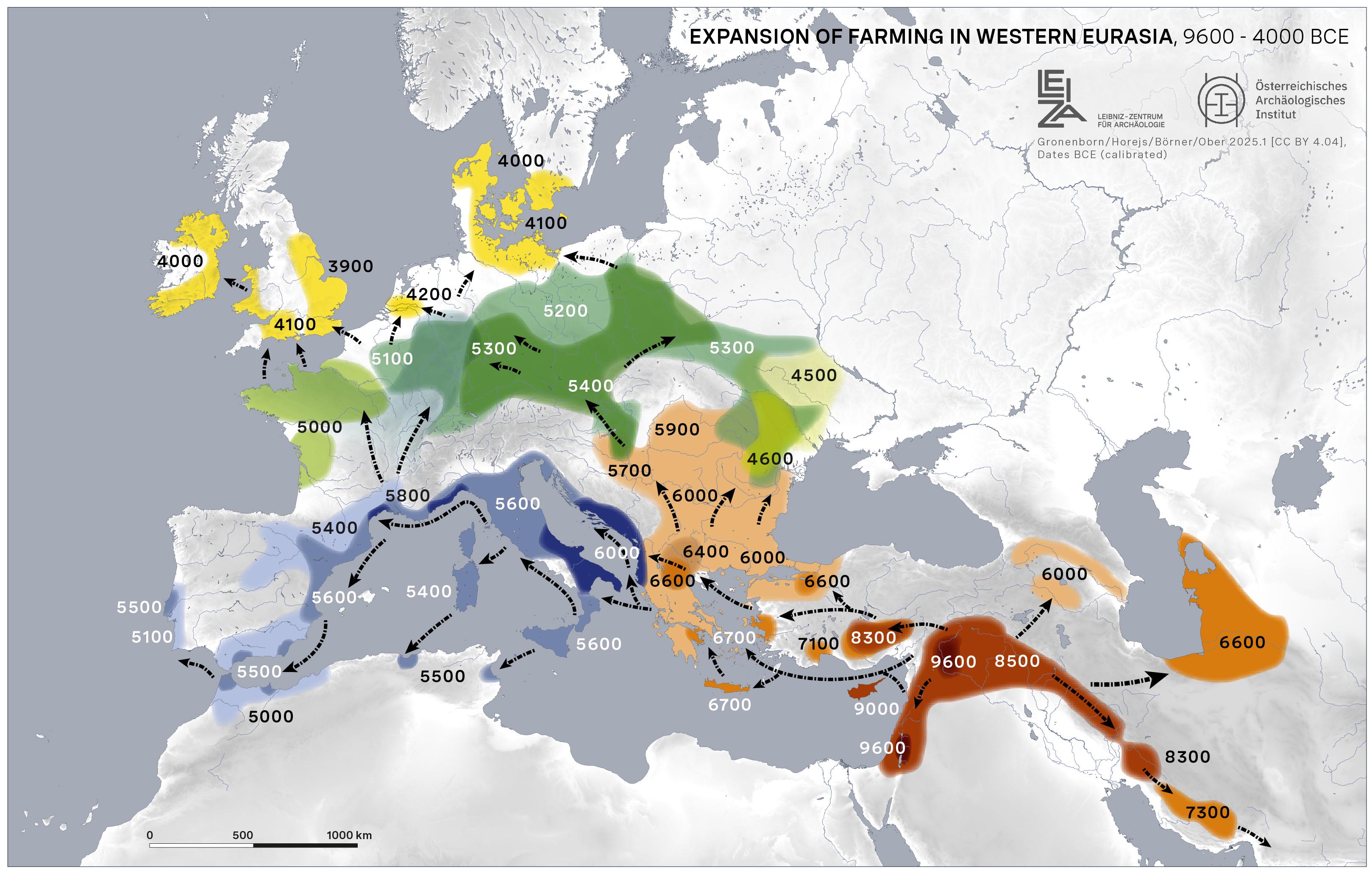Farming Expansion Map in Western Eurasia, 9600-4000 BCE


David Chen
Data Visualization Specialist
David Chen is an expert in transforming complex geographic datasets into compelling visual narratives. He combines his background in computer science ...
Geographic Analysis
What This Map Shows
The map titled "Expansion of Farming in Western Eurasia, 9600-4000 BCE" illustrates the spatial distribution and growth of agricultural practices across a vast region that includes present-day countries like Turkey, Iran, and parts of Eastern Europe. This visualization captures a pivotal transformation in human history, marking the transition from nomadic hunter-gatherer societies to settled agricultural communities. By pinpointing areas where farming began, flourished, and spread, the map provides insights into early agricultural innovation and its significant impact on societal development.
Deep Dive into Agricultural Expansion
The period between 9600 and 4000 BCE was crucial for the evolution of human societies in Western Eurasia. During these years, the advent of farming fundamentally altered the way people lived, worked, and interacted with their environments. Prior to this era, most human groups relied on hunting and gathering, adapting to the natural world around them. However, as climatic conditions became more stable following the last Ice Age, opportunities for agriculture emerged.
Farming, particularly the cultivation of staple crops such as wheat and barley, allowed communities to settle in one location, leading to the establishment of villages and eventually complex societies. Interestingly, this shift not only brought about food security but also a surplus that could support larger populations. Archaeological evidence suggests that the Fertile Crescent, a region that includes parts of modern-day Iraq, Syria, Lebanon, Israel, and Jordan, was one of the earliest centers of agricultural development.
What’s fascinating is how the agricultural practices varied regionally. In the northern areas, people tended to adopt a mixed farming approach, combining crop cultivation with animal husbandry. In contrast, southern regions often focused more heavily on cereal grains, capitalizing on the rich alluvial soils deposited by rivers. This diversity in farming techniques reflects the adaptability of early societies to their unique geographical and climatic conditions.
Moreover, as farming spread, it prompted significant technological advancements. The invention of tools such as sickles and plows revolutionized agricultural practices, increasing efficiency and yield. This technological progression was crucial for sustaining larger communities and facilitating trade, as surplus goods could be exchanged for other resources or services.
Regional Analysis
Looking closely at the map, we can see distinct regional trends in farming expansion. In the southeastern part of Western Eurasia, particularly in the Anatolian Peninsula, evidence of early farming communities dates back to around 9000 BCE. Sites such as Çatalhöyük showcase how agriculture was deeply intertwined with social and spiritual life, demonstrating the complexity of these early societies.
Moving northwest, we observe a different agricultural trajectory in the Danube River basin. Here, farming began to take root around 5500 BCE, with communities making use of the fertile river valleys. The introduction of farming in this area brought about the development of the Linear Pottery culture, known for its distinctive pottery styles and settlement patterns, which illustrate a shift towards more permanent habitation.
Further to the north, in regions like the Carpathian Mountains, the adoption of agriculture was slower, often due to harsher climatic conditions. Here, communities remained more reliant on hunting and gathering for longer periods, indicating a diverse pace of agricultural advancement across Western Eurasia. This variation is essential to understanding the broader narrative of human adaptation and resilience.
Significance and Impact
Understanding the expansion of farming in Western Eurasia during this timeframe is significant for several reasons. First, it highlights the foundations of modern agriculture and food systems. The practices developed during this period laid the groundwork for the agricultural revolutions that would follow in subsequent millennia.
Moreover, the transition to farming had profound implications for societal structures. As communities settled, they began to form more complex social hierarchies, leading to the rise of governance, trade, and eventually urbanization. The interconnections between agricultural practices and social organization illuminate the intricate tapestry of human development.
Today, as we face challenges related to food security, climate change, and sustainable practices, revisiting early agricultural innovations can provide valuable insights. By learning from the past, we can better understand the impacts of our current agricultural practices and seek solutions that honor both our heritage and the environment. The map serves as a powerful reminder of the transformative power of agriculture and the enduring relationship between humans and the land they cultivate.
Visualization Details
- Published
- August 19, 2025
- Views
- 100
Comments
Loading comments...